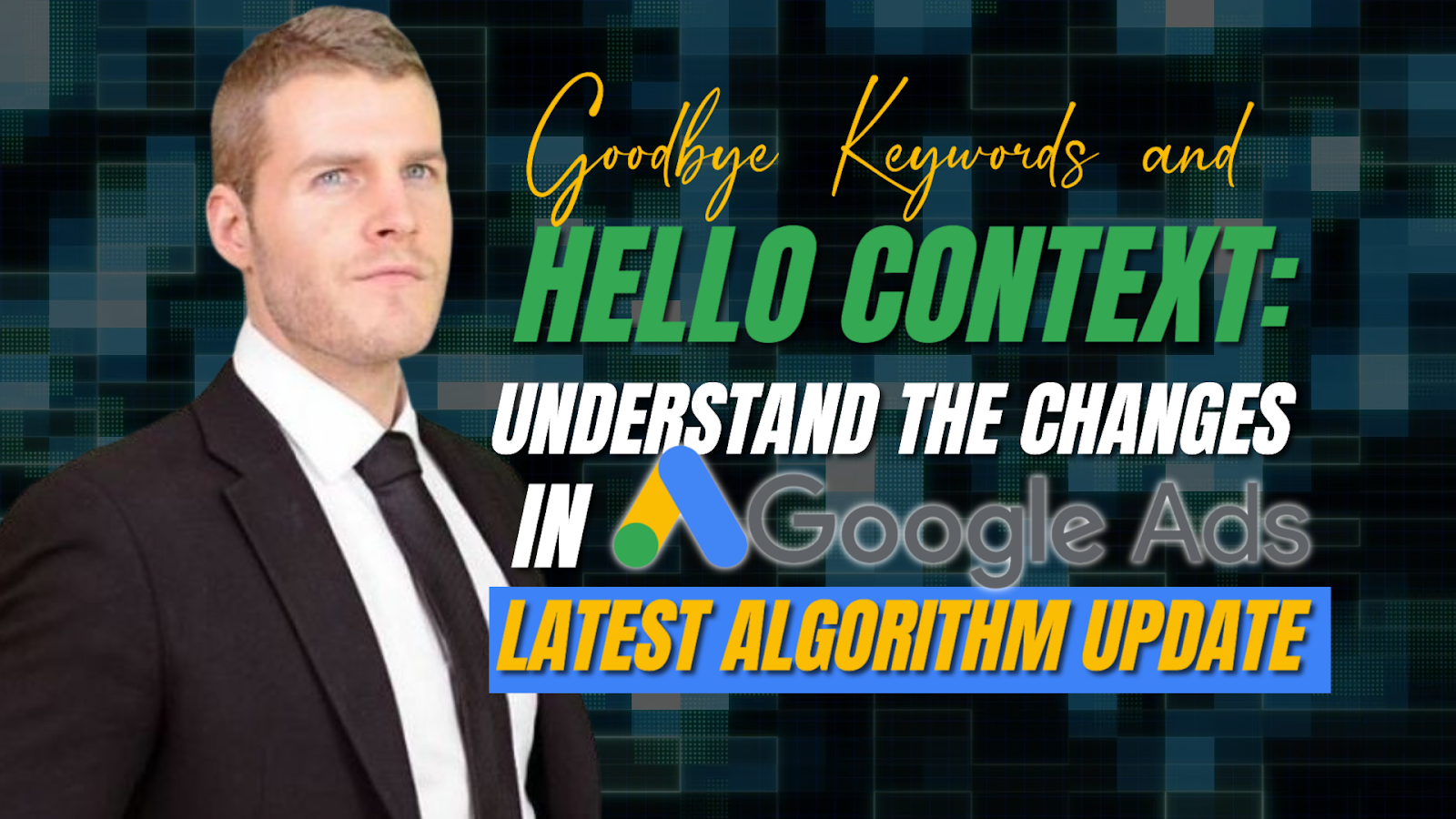
Goodbye Keywords and Hello Context: Understanding the Changes in Google Ads’ Latest Algorithm Update
The digital marketing landscape is ever-evolving, and businesses must constantly adapt to stay competitive. Google Ads, in particular, has seen major changes over the past few years. According to a recent report, spending on Google Ads will increase significantly in 2023, with businesses spending anywhere from $9000 to over $30,000 monthly on their marketing campaigns.
One change that has significantly impacted Google Ads is the shift from keyword-based to contextual relevance targeting. Before this, marketers heavily relied on keywords to target their desired market potential. However, this approach was prone to manipulation and often led to poor user experience.
To address this issue, Google Ads recently released a new algorithm update that places more emphasis on contextual relevance. This update has revolutionized how marketers target their audiences and aligns with customer purchase journeys. In this article, we will explore the changes brought about by this update and discuss strategies for adapting to them.
The Rise and Fall of Keywords
The importance of keywords in the past was undeniable. Marketers relied heavily on keyword targeting as it allowed for precision when targeting a market and provided insight into how customers searched for products or services. Moreover, it enabled marketers to craft creative campaigns that resonated with their target audience.
However, this reliance on keywords could also lead to abuse. As marketers began to pack their ads full of keywords to get more clicks, user experience suffered greatly. Search results were clogged up with irrelevant content not tailored to the user’s needs and search intent, leading to wasted time and money for both the marketer and the customer.
In response to this issue, Google Ads released a new algorithm update emphasizing contextual relevance and quality signals. This update seeks to reward ads tailored to the user’s search intent rather than those containing many keywords. As such, it is now essential for marketers to focus on understanding their target audience and crafting more relevant and engaging ads.
This shift away from keyword-based targeting has been a major change for marketers. Crafting creative campaigns that resonate with their audience is now essential, and it requires more thought and effort than simply stuffing ads with keywords. You must take the time to understand customer purchase journeys and tailor your ads accordingly to maximize the potential of Google Ads.
The Contextual Relevance Revolution
Contextual relevance is an upgraded form of keyword targeting focusing on delivering highly relevant ads to users based on their search intent. It involves interpreting user queries and understanding the context to display ads matching users’ needs.
1. What Are the Advantages of Contextual Relevance Over Keywords?
A campaign management strategy heavily reliant on keywords can be beneficial in the short term, but it is not sustainable for long-term success. Contextual relevance has been introduced to give marketers a more effective and efficient way of targeting their audiences. It has several advantages it offers over keyword targeting.
Improved User Experience
Contextual relevance allows marketers to tailor ads to their target audience’s needs and search intent. This provides users a more enjoyable and efficient experience when searching for products or services, leading to higher engagement and satisfaction. As a result, contextual relevance offers potential long-term benefits such as increased loyalty and brand recognition.
Increased Relevancy
Contextual relevance allows marketers to narrow down their target audience and deliver ads that are more likely to convert. By recognizing user searches and understanding the context behind them, you can create campaigns tailored to the specific needs of potential customers. This increases the relevance of ads, making it easier to capture user attention and generate meaningful interactions.
Furthermore, contextual relevance eliminates many irrelevant clicks and wasted spend. By only targeting users searching for products or services similar to what is being advertised, you can ensure their ads are seen by the right people, leading to better engagement.
Higher ROI

By targeting users more accurately, contextual relevance helps marketers gain a higher ROI on their campaigns. This is achieved by reducing wasted spend, focusing budgets on high-quality leads, and driving conversions with more relevant ads. In addition, contextual relevance also allows marketers to measure the performance of their ads in real-time and make changes accordingly.
2. Examples of Contextual Relevance in Google Ads
Google Ads provides numerous examples of marketers leveraging contextual relevance to reach their target audience. Here are some common examples:
- Dynamic search ads: Marketers can use this feature to tailor ads based on the content of a user’s search query.
- Display targeting: This feature allows marketers to target users based on their interests, behaviors, and other demographic information.
- Remarketing: You can create campaigns that target users who have previously interacted with your brand, products, or services.
3. The Role of AI in Understanding Context
The role of AI in understanding context is essential to the success of contextual relevance. AI-powered algorithms can interpret user queries and understand their intent, enabling marketers to create more effective campaigns. By combining natural language processing (NLP) and machine learning (ML), marketers can gain insights into user behavior, preferences, and interests that optimize the delivery of ads.
AI-powered algorithms also enable marketers to identify optimal solutions for their campaigns. AI can anticipate user needs by analyzing user data and generating targeted ads that maximize conversions. Marketers can use AI to monitor campaigns continuously and make real-time adjustments to ensure they deliver the best results.
Finally, AI-driven solutions provide a more cost-effective approach to contextual targeting than manual methods. AI allows you to save resources by automating analyzing user data, and identifying the best strategies. This reduces the need for manual labor, making optimizing campaigns for success easier and more cost-efficient.
The Impact of the Latest Algorithm Update

Google recently announced a core update to its search algorithm that emphasizes the importance of contextual relevance in ads. This update will shift the focus away from keyword-based campaigns, allowing marketers to deliver more targeted, relevant ads. As a result, advertisers must now adjust their strategies and embrace the use of context when creating ad campaigns.
1. Effects of the Update on Keyword-Based Campaigns
The latest Google Ads algorithm update creates a more complex structure for keyword-based campaigns. As such, you must adjust your strategies to ensure they target the right audience with the most relevant ads. Failing to do so may result in ineffective campaigns that lack focus and don’t produce desired results.
Here are some of the effects of this update on keyword-based campaigns
Increased Focus on User Intent
Companies must now take user intent into account when planning a keyword-based campaign. This means that ads must be tailored to the specific query of a user rather than simply using high-quality keywords to capture as many impressions as possible. The best keyword-based keywords relevant to the user’s query demonstrate an understanding of their needs.
Greater Emphasis on Content Quality and Relevance
With the focus on context, keyword-based campaigns must now be more strategic than ever. Marketers must ensure their content is high quality and relevant to the user’s query to capture interest.
Here are some ways to ensure this:
- Optimizing content for SEO to ensure it’s visible to the right audience.
- Crafting content focused on providing users value rather than simply promoting a product or service.
- Using keywords with precision ensures that ads are only displayed to users likely to be interested.
Improved Understanding of Natural Language Queries
Advertisers must now understand the nuances of natural language queries to create effective campaigns. To do so, they should utilize advanced search techniques such as voice search and semantic analysis to identify the intent behind a user’s query. This will allow you to create more relevant ads that address their needs.
Additionally, you should use AI-powered solutions that can help you quickly generate natural language queries based on user data.
Decreased Importance of Exact Match Keywords
As the new algorithm focuses on context rather than keywords, the importance of exact-match keywords has decreased. Marketers must now prioritize keyword features related to the user’s query and ensure they are included in their campaigns. This could include using long-tail keywords, synonyms, and related words to capture a broad audience. Additionally, marketers should use contextual targeting options such as location or device type to refine their ad targeting further.
2. Advantages and Disadvantages of the Update
Implementing Google Ads’ latest algorithm update brings both advantages and disadvantages to marketers. To determine whether or not this update is right for their campaigns, it’s important to understand these benefits and drawbacks.
Here are some of the advantages of this update:
- Greater accuracy in targeting users as marketers must now consider user intent when crafting ads.
- Increased flexibility and relevance as advertisers can use contextual targeting options to refine their target audience further.
- Improved understanding of natural language queries as AI-powered solutions helps marketers quickly identify the intent behind a user’s query.
And here are some of the disadvantages of this update:
- The decreased importance of exact-match keywords can make planning keyword-based campaigns more difficult.
- It may require additional resources as content must be optimized for SEO and crafted with users in mind.
- Companies must comprehensively understand the nuances of natural language queries to create effective campaigns.
While the new algorithm brings many advantages, advertisers must adapt to these changes to make the most of their campaigns and maximize their return on investment.
What Are the Strategies for Adapting to Contextual Relevance?
To ensure that campaigns remain successful after the algorithm update, marketers should develop strategies to help them meet their performance goals.
Here are a few strategies to consider:
1. Understanding the Target Audience

Researching and understanding target audiences is essential for success with the algorithm update. Marketers should consider demographics, interests, customer behavior, and more to better understand who they are targeting. This can help craft campaigns more likely to capture your target audience’s attention.
2. Creating Contextually Relevant Ads
Once marketers understand their target audience, they should create contextually relevant ads. This involves using language and content that resonates with the user’s query and targeting options such as location or device type to refine their ad targeting further. Additionally, utilizing long-tail keywords, synonyms, and related words can help capture a broader audience.
3. Use Negative Keywords to Avoid Irrelevant Clicks
Using negative keywords helps prevent marketers from targeting irrelevant queries and wasting ad spend. You should identify keywords unrelated to their campaigns or target audience and add them to their negative keyword list. This will ensure that ads are only served to users likely interested in the brand’s offering.
4. Continuous Optimization
Google Ads campaigns should be continuously optimized to deliver the desired results. Here is a list of items to remember when optimizing campaigns after the algorithm update.
- Monitor ad performance by regularly reviewing the performance of ads and tweaking campaigns as necessary.
- Test different strategies by experimenting with different approaches to see what works best for your campaigns.
- Refine keyword targeting by focusing on long-tail keywords, related words, and synonyms that capture relevant queries.
- Leverage automation tools to automate routine tasks and identify opportunities for optimization quickly.
Embrace the Contextual Relevance Revolution and Optimize Your Google Ads for Success
The latest algorithm update from Google Ads has revolutionized how marketers target their audiences. Instead of relying on keywords, marketers must now focus on contextual relevance. This shift offers a more user-friendly experience and better aligns with customer purchase journeys. To adapt to this change, marketers must be aware of the impact of the algorithm update and strategize accordingly.
The key is to focus on creating campaigns tailored to customers’ needs and preferences. With this approach, businesses can optimize their Google Ads for maximum success. Whether you are new to Google Ads or an experienced marketer, now is the time to embrace the contextual relevance revolution and take your campaigns to the next level. Start optimizing your Google Ads today and take advantage of the latest algorithm update.
